“One thing I’d always wanted to do, and had even worked on a little bit in the past, was trying to make adventure games more approachable,” said Brøderbund programmer Dane Bigham.
The following is an excerpt from “Break Out: How the Apple II Launched the PC Gaming Revolution,” a new book by David L. Craddock, out now.
Like so many of his peers in the nascent games industry, Bigham had been both captivated and frustrated by Colossal Cave Adventure. Because the game’s thesaurus was so limited, players had to rack their brains to come up with the exact synonym the game was looking for.
The problem, as Bigham saw it, was that Colossal Cave‘s authors had been constrained by the technology of the day.
The Apple II was capable of much more than a mainframe — namely, a graphical interface that streamlined adventuring. Rather than paging through a thesaurus and trying every word until one clicked, Bigham envisioned a small adventure game with an elegant menu overlay. “I thought, Maybe I could write an adventure game for kids.”
After a few days, he had a few rooms mapped out — virtual containers able to hold treasures, characters, and other data. “I was starting to do that, and had a little bit of the physical layout and framework that you see in Carmen, where you could pick commands from a little menu in the lower right-hand corner, and you got results somewhere else [on the screen].”
Rubber Room
While Bigham built his menu interface, other developers filled in details. Lauren Elliott and Gene Portwood, Jr., artists at Brøderbund, bounced ideas off of each other in their office, known around Brøderbund as the rubber room. “The artists were considered… crazy is not the right word,” Bigham says.
He thinks for a moment, and comes back with a suitable descriptor: “Nutty. Their room was full of toys: these squeeze toys that you’d squeeze, and the eyeballs would pop out, all that fun stuff.”
Before it became a physical space, the rubber room started as an idea. Elliott and Portwood exchanged banter in the hallway while conversing with colleagues, and then continued discussions in their office. Programmers and artists began popping in to ask for their input. Ideas swirled, and inspiration struck like bolts of lightning. Portwood tended to be at the center of creative storms.
“Gene was such a character, such a funny guy,” Bigham says of Portwood, who died of a heart attack in the summer of 2000. “He was the guy who played practical jokes around the office, and had the creative bent to do it. He was a funny, crass artist who had worked for Disney, and the kid in a candy store — a game company where he could create and participate in all this creation.”
Portwood had the clout to get away with pulling practical jokes. Bypassing college and landing a dream job on Disney’s animation team in 1950, he hit the canvas drawing, illustrating scenes for iconic films including Lady and the Tramp and Sleeping Beauty.
Portwood joked that his expertise lay in crickets: He drew hundreds of renditions of Jiminy Cricket that welcomed viewers to the anthropomorphised conscience’s weekly TV show.
The 1940s and ’50s were not profitable for the “House of Mouse.” Portwood ended up taking jobs at banks to provide stable income for his family. An artist at heart, Portwood kept a close eye on emerging forms of animation — computer games in particular. A chance series of events led to him befriend Doug and Gary Carlston, who hired him in late 1980.
Portwood and Elliott’s rubber room doubled as the staging ground for some of Portwood’s best gags.
One recurring joke was impersonating programmers looking to get software published by Brøderbund. He’d throw together prototypes, brand them with hilarious titles, and write letters under aliases, such as an arrogant programmer who declared that Brøderbund should feel privileged that he deigned to submit his masterpiece.
“We’d start it up, and a story would appear on the screen. The text would appear as if being typed in real time. It would slowly get faster and faster, and then just zip by. Then it would stop, and you’d see: Loading graphics. Loading sounds. Loading smells.
Then the game would start, and it would be this graphic game where you’d get stomped and killed right away,” Bigham says, dissolving into laughter. “It was so much fun to work with Gene.”
Once Bigham’s menu-driven system progressed to the point where he could start brainstorming game concepts to wrap around it, Bigham paid a visit to the rubber room. Portwood and Elliott listened as he laid out his idea: an adventure based on the children’s game of cops and robbers.
Portwood raised his hand in a so-so gesture. The premise was bland. Not willing to let the idea go, Bigham pushed ahead until he hit a wall. “I wrote a whole prototype in text where you’re chasing a robber, and their henchmen would be stealing two things at a time, and you had to keep track of different thefts at the same time.
I said, ‘Wow, this is way too hard. I actually have to make this simpler.’”
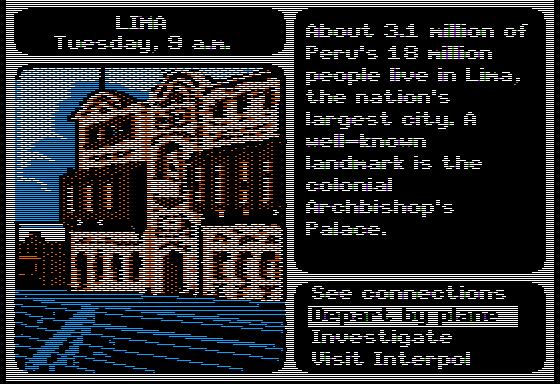
Bigham pared down the idea. Instead of pursuing two thieves at once, players would chase one. Focusing on a single criminal at a time would keep the menu simple and the screen more organised. Portwood nodded, warming to the notion. Players would track criminals by analysing clues and determining which menu option to select based on solutions to the clues.
No one remembers how long Bigham’s embryonic game concept remained centered on cops chasing crooks. What they do recall is Gary Carlston was the one who suggested switching gears to a geography motif. “We moved to Germany for a year when I was eight and travelled all around Europe,” Gary remembers.
“Back then, in the ’50s, this wasn’t very common. It got us interested in geography. My parents liked to travel, and both my brother Doug and I got the bug.”
Not everyone seemed as excited about the shift in direction. “What I remember most is that Dane [Bigham] thought the idea was a dog and that I was taking advantage of our friendship by asking him to program it,” Gary says. “Dane is captain of the ice hockey team I play on. We’re still friends thirty-two years later.”
Convinced that his game was on the fast track to disaster, Bigham resigned himself to continue writing his menu-driven interface. Meanwhile, the Carlstons hunted for a writer to turn the geography idea into a cohesive narrative. Their search led to David Siefkin.
“My wife was a cooking teacher in Berkeley, and one of her students, Joanne Koltnow, worked for Broderbund at the time, and knew that I was interested in computer games,” Siefkin says. “She arranged a meeting for me with [Doug] Carlston.”
Siefkin remembers his initial meeting with Gary. “His idea was to create a game based on the Great Cities series of Time-Life books. There wasn’t anything much more specific than that.”
“Before I had gotten very far, I was told that the idea had changed, and that instead it would be based upon the World Almanac, and that a copy would be bundled with the game. I was given a copy of the almanac, and I started with that.”
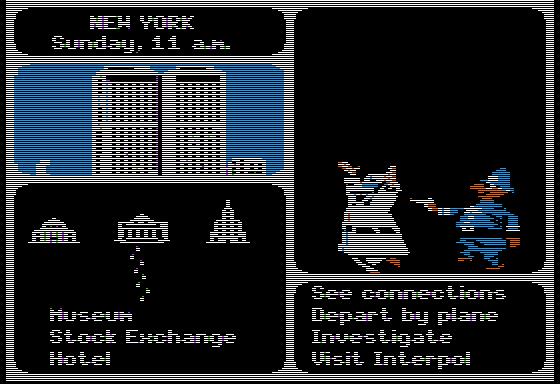
Writing a storyline around people and places happened to be right up Siefkin’s alley. “Before I wrote the script for the game, I had travelled around the world for nine months, having to learn about different currencies, languages customs, and landmarks. I wanted a game that introduced these things to young game players, and hoped it might inspire them to make similar trips.”
Siefkin did some of his best writing in quiet, scenic spots. He gathered his writing supplies and headed to Strawberry Canyon, an outdoor pool on the Berkeley campus. Stretching out in a lawn chair beside a three-lane pool, he thought about how the game might be structured.
Siefkin was well-versed in text-adventure tropes. A friend at Berkeley had introduced him to Colossal Cave Adventure, helping him get the hang of typing in commands for the text parser to analyse. Siefkin got sucked in; he loved the precept of solving puzzles to advance through rooms and collect treasure. For Brøderbund’s game, however, he imagined a much larger scale.
“When I played Adventure, I wondered why the fantasy world of the treasure hunt in the cavern couldn’t be transposed into the real world, with real clues and real places, which to me was much more interesting. I also imagined that players would use trial and error to track the villain, and that they would learn about the world from their experience.”
His script defined the player’s role and objectives. The player, a detective, would start in one location on the globe and be given a bit of trivia. Multiple-choice answers would be displayed on a menu, and choosing the correct answer would reveal where players needed to go next, and another clue. “The first draft version had a number of villains, with one chosen at random, and a treasure hidden in an obscure place somewhere around the world, with clues based on real-world things, such as language or currency, that could be found in the almanac.”
After deciphering half a dozen clues or so, players would apprehend the criminal and recover the treasure. From there, another case featuring a villain and treasure would begin. Brøderbund approved Siefkin’s early script, which he clarified was more an outline of ideas: incorporate real-world clues based on information from the World Almanac to send players hunting around the globe.
Reading over the script, Brøderbund project manager Katherine Bird skimmed the short bios of the villains Siefkin had invented. One name in particular caught her eye: Carmen Sandiego. “In my draft, she was only one of several villains,” Siefkin explains.
“I wanted an exotic name, and took it from the singer Carmen Miranda and from Carmen, the adorable St. Bernard dog of my old roommates in San Francisco.” From there, he explained, “The design team brought her to life. I invented the name, but the design team really created the personality of Carmen.”
(Wo)manhunt
Bird latched on to the name Carmen Sandiego for the same reasons Siefkin had: it was exotic and mysterious — the perfect qualifiers for a villain that would appeal to boys and girls. “We wanted a character that girls could relate to and didn’t give much thought to her being a crook,” says Gary Carlston. “We came up with a back story about her maiden name being something Swedish to deflect concern about her being a bad role model for Hispanic girls.”
Carmen Sandiego suited another purpose. The game would be called Where in the World is Carmen Sandiego?, a title that succinctly communicated the player’s ultimate objective: track down Carmen and arrest her.
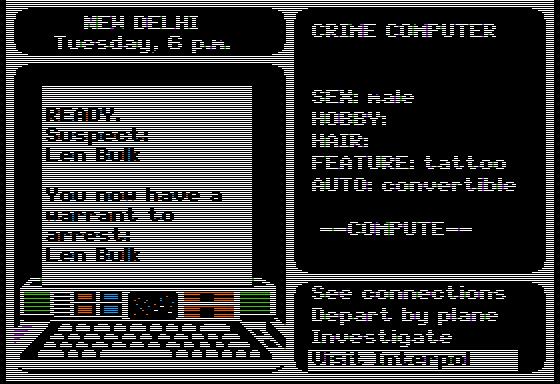
But players couldn’t bring Carmen to justice right away. She was the proverbial carrot on a stick, the final boss that players only encounter once they have cleared a path through her lackeys. Piecing together a structure that would function as both an ongoing narrative and a game structure, Bird and the development team created two organisations. The first was V.I.L.E., or Villains’ International League of Evil, a cast of thieves.
There was Katherine Drib, whose last name was an anagram of producer Katherine Bird. Carmen herself was modelled after Marsha Bell, Brøderbund’s manager of marketing services from 1984 through ’89.
“Most of the characters were, in fact, different employees of the company,” Doug Carlston says. “People enjoyed dressing up and coming up with names and so forth. They tried to get as wild and outside-the-box as they could.” Other names were coined as puns — Anita Bath was a play on I need a bath, while Ken U. Sparadigm worked out to Can you spare a dime.
Standing in opposition to V.I.L.E. was ACME Detective Agency, the acronym a running joke in comedy that stands for A Company that Makes Everything. Entering their name registered players as an ACME gumshoe, the lowest rank on the detective totem pole. Every game session charged players with tracking down a V.I.L.E. operative, and cracking a set number of cases earned players a promotion to the next rank up.
“One thing I thought was unique about Carmen was you logged into the game, and it kept track of your progress,” says Bigham. “It actually kept track of your [cases] and called you by name. I thought that was kind of unique.”
Earning higher ranks brings players one step closer to apprehending Carmen, who always manages to slip through ACME’s fingers. “To paraphrase Pancho and Lefty, ‘All the Federales say, we could have had her any day. We only let her slip away, out of kindness, I suppose,’” Gary Carlston quips. He pauses. “And a desire to sell lots of software.”
Capturing Carmen and her band of thieves took a backseat to compulsive gameplay. Players start each game session in a country where a crime occurred, and receive a strict, to-the-minute deadline — say, Wednesday, June 3rd, at 5:00 p.m. Their goal is to gather clues by selecting options in Bigham’s menu interface, which lets them interview witnesses at major landmarks.
For example, a witness might recall the suspect converting his or her currency to pesos. When players feel they have gathered sufficient clues, they pull up the travel menu and jet off to the country indicated by the clues. Witnesses either express confusion to their inquiries, indicating they guessed wrong, or perk up and offer new intel.
As players follow breadcrumb trails and advance in rank at ACME, cases become tougher. Time limits grow tight, and clues befuddle. “I remember there being discussion about the categorization of clue: what was easier, what was harder, and how to move people through that,” says Bigham.
“The one major change I asked for was that it focus on the big stuff, like where Australia is, before getting into the currency of Lesotho,” adds Gary Carlston.
As much a game as an educational program, Carmen introduces elements of suspense and reward to player actions. Actions like interviewing witnesses, travelling, and sleeping drain hours from the allotted time given to complete a case. Witnesses gradually divulge particulars about the suspect, such as gender, hair colour, and notable features like tattoos and the automobile they drove.
Players must enter those details into their crime computer in order to eliminate false leads and obtain a warrant for a specific criminal. Arresting the wrong person, or failing to obtain a warrant, botches the investigation. As players close the gap, suspects grow desperate and aggressive. Traps, like flowerpots falling from window sills and knives hurled from off-screen, signal that players are nearing a confrontation.
When they smoke the suspect out of hiding, an animation of a chase sequence ensues. Back at HQ, players receive a letter of commendation and an update on how many cases they need to solve before they receive a promotion.
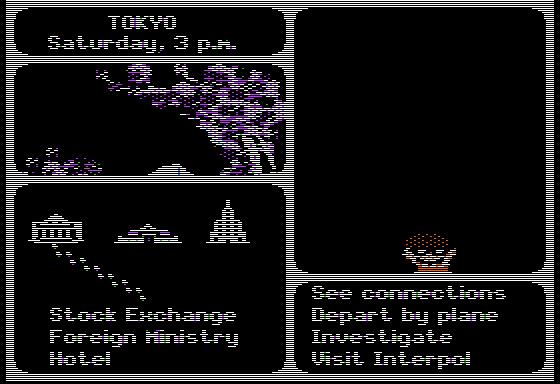
While cases are really Trojan horses for educational trivia, Carmen‘s number-one goal was to entertain. “We were always very clear that we weren’t trying to sell games to people to make them smarter,” says Doug Carlston.
“We wanted to sell the games we thought they would enjoy playing. One of the things we enjoyed doing was learning, and we tried to offer that in a context that was similar to the way we learned. I grew up learning through games. That’s basically how I think people improve their physical and intellectual skills. Since I’d done that all my life, it was a natural thing for us to try.”
Seattle Summer
Dane Bigham had a love-hate relationship with Carmen. “I did not think I had a gem or a hit on my hands. Not at all.”
Although he had taken it upon himself to write the backbone of an adventure-game interface suited for kids, Bigham quickly soured on Carmen. He’d been inspired to program computer games because of action-packed hits like Choplifter. Carmen‘s shift from a cops-and-robbers hunt to what amounted to a trivia quiz fell on the opposite end of the spectrum. “I certainly wasn’t going to quit. I was looking for permission.”
Near the end of Carmen‘s development, another Lode Runner conversion came up on the docket. To Bigham, porting Doug Smith’s game over to the Mac was a chance to work on a game guaranteed to be a hit, and a return to the types of games he enjoyed.
Before he could pounce, another Brøderbund programmer scooped up the project. Bigham returned to Carmen, dejected. Another opportunity came up right away. Dan Gorlin, author of Choplifter, had founded his own studio, Dan Gorlin Productions, down the street from Brøderbund. Impressed by Bigham’s coding skills and work ethic, Gorlin extended him an offer.
Excited, Bigham pulled Gary aside. The response took him aback. “I said to Gary, ‘Dan wants me to work with him, and I think that would be really cool. How about somebody else finishes Carmen?’ Gary looked at me, pointed at my head, and said: ‘Dane, Carmen is in there. I need you to finish it.’”
Bigham returned to his desk. As he worked, his resentment toward the project grew. Brøderbund had hoped to ship the game in 1984 and had promised a bonus for finishing early. January 1985 rolled around, and Carmen still wasn’t done. Bigham’s bonus check slipped through his fingers.
He finished Carmen that summer. Another job offer came through, and he seized it. “After I finished Carmen, I took a short leave of absence from Brøderbund to go work for Doug Smith for the summer up in Seattle. That was by far the best summer of my life.”
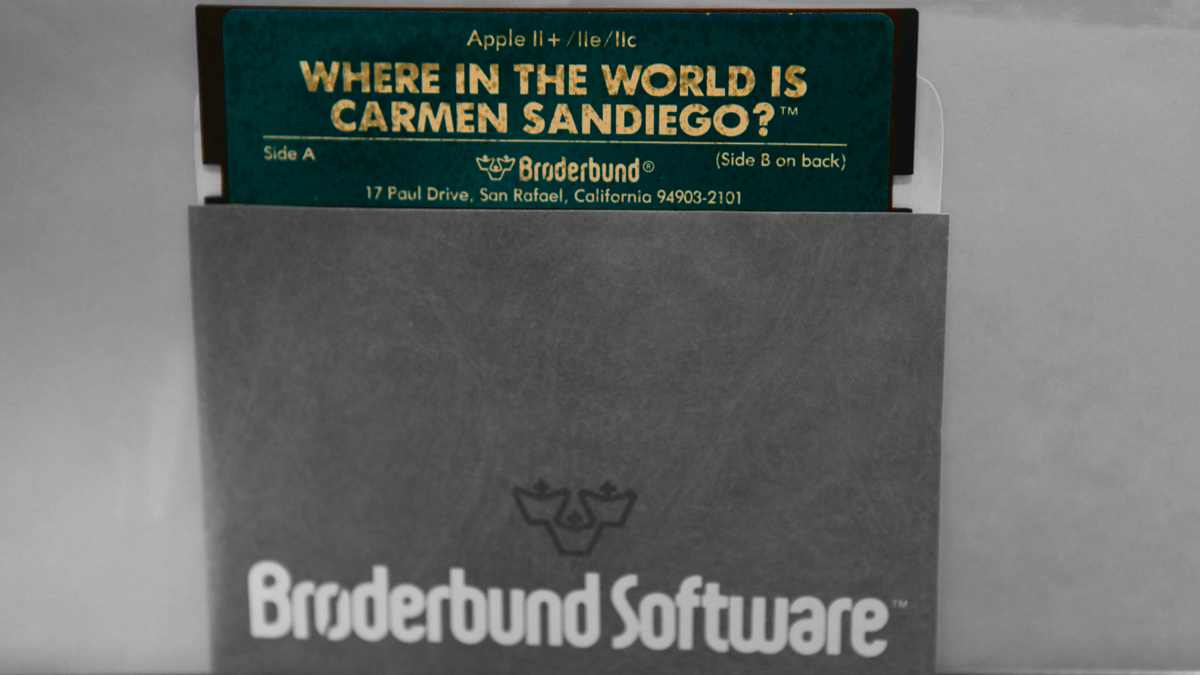
Original image: Jason Scott/CC BY 2.0
Following his whirlwind summer in Seattle, Bigham returned to Brøderbund feeling refreshed. His colleagues greeted him with surprising news. “Bill Holt, our evangelist who went to user groups and was basically the creative side of sales, would come back from these trips and say, ‘People really like Carmen. They’re really taken to it.’ And I would say, ‘Yeah, we’ll see.’”
In an ironic twist, teachers, not consumers walking into stores looking for hot new action games, were responsible for giving Where in the World is Carmen Sandiego? a boost. “We didn’t want to call it ‘educational,’” Bigham explains. “We wanted to call it ‘exploration.’ Educational meant really boring software; it’s ironic that it got tagged as an educational game. That was not our objective, really.”
Doug Carlston corroborated Bigham’s recollection of Brøderbund’s marketing strategy for the game. “Carmen Sandiego was always intended as a game. It was the school systems that decided it was educational, not us.”
Had teachers not taken an interest in Carmen and ordered copies for use in their classrooms, Carmen might have disappeared without a trace. “It suddenly started to take off eighteen months after it was released,” Gary Carlston recalls. “Word of mouth in the educational community did it, I think.”
Before long, Carmen became an essential product in schools. The game’s success came as a shock to Dane Bigham. “Probably the first indication for me was getting a $US10,000 ($12,496) check. Something like that. Like, here, have ten grand. Not part of your salary; just an extra check.”
Doug and Gary Carlston made sure that everyone who’d had a hand in developing the game shared in its success. David Siefkin, who had joined the Foreign Service after completing his script, was as happy to be associated with the game as he was by his cut of royalties.
“Once I was in the South of France, near the Spanish border, turned on the television, and there was Carmen, talking in Spanish, on Spanish television. That was a nice feeling. The greatest satisfaction I got from working on Carmen was knowing that it got young people interested in the world outside the United States.”
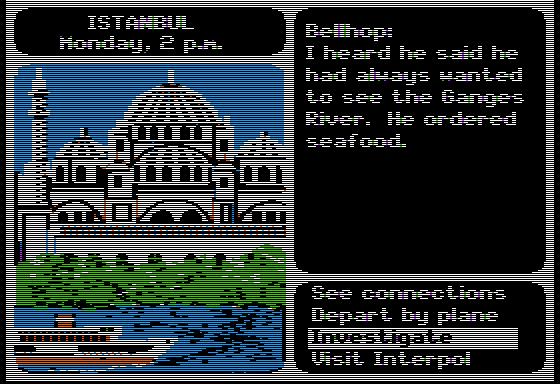
In retrospect, it’s not surprising that Where in the World is Carmen Sandiego? became a touchstone of gaming and computer culture, devising a reward loop that entices players to keep going at just the right moments — getting a positive reception upon questioning a witness about crimes, obtaining warrants, closing in on suspects, rationing out promotions from ACME that — made Carmen such a joy to play.
Thumbing through a copy of the World Almanac to look up the capital of Peru, or the currency used in Algeria, or the habitat of the indigo macaw, didn’t feel like homework. It made players feel like ace detectives hot on the heels of the world’s most notorious criminals. “Certainly it wasn’t irrelevant,” says Doug Carlston in regards to the book’s effect on Carmen‘s popularity. “You could play the game without the almanac, but people did like the exploration and research.”
“It did what I wanted it to do,” says Gary Carlston of the Almanac’s inclusion, “which was to get the kids to thumb through the almanac to solve the clues. The irony is that the almanac is a terribly organised reference book, but it’s full of fun stuff.”
Dane Bigham’s feelings toward Carmen have, understandably, softened over the years. “I was very proud to have created that gameplay. That gameplay alone was something I worked on carefully. I did a version of it that was just too hard, so that progression was something I worked on very carefully: the fact that you could accomplish the first cases without it getting too difficult, and then work your way up gradually rather than getting hit over the head right away.”
Break Out: How the Apple II Launched the PC Gaming Revolution by David L. Craddock is out now.
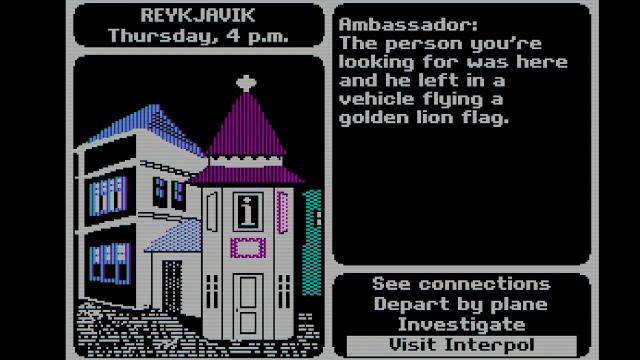
Comments
One response to “The Making Of Carmen Sandiego”
As a kid, my dad was an architect and insisted on our household being Mac only because it suited his profession more.
I grumbled and whined because I couldn’t play the same games as my friends, but looking back, I got to experience some weird and idiosyncratic titles on those early macs. Carmen was one of them. Good times!
Great article.